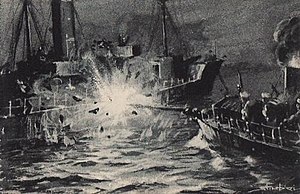Action off Măcin
| Action off Măcin | |||||||
|---|---|---|---|---|---|---|---|
| Part of the Russo-Turkish War (1877-1878) and Romanian War of Independence | |||||||
 | |||||||
| |||||||
| Belligerents | |||||||
|
|
| ||||||
| Strength | |||||||
|
1 torpedo boat 3 Romanian sailors 2 Russian sailors |
1 monitor 51 Ottoman sailors | ||||||
| Casualties and losses | |||||||
| None |
1 monitor sunk Unknown casualties | ||||||
The Action off Măcin was a naval engagement between a torpedo boat of the Romanian Navy with a mixed Romanian-Russian crew and a monitor of the Ottoman Navy which took place during the 1877-1878 Russo-Turkish War. It was the first time in history that a torpedo craft sank its target without being sunk itself.
Background
The Principality of Romania acquired its first torpedo boat in 1875, two years before the start of the Russo-Turkish War. She was built in the United Kingdom. Named Rândunica, she was a 10-ton launch armed with a single spar torpedo. She was powered by a steam engine giving her a top speed of 8 knots and had a crew of five.
Romania joined the Russo-Turkish War in April 1877, signing a treaty of alliance with the Russian Empire which allowed the Russian Army to cross through Romanian territory. On 10 May, Romania declared its independence.[1]
Engagement
According to the Russian-Romanian treaty signed in April that year, Rândunica served under joint Romanian-Russian command. She was also known as Tsarevich by the Russians. Her crew consisted of two Russian Lieutenants, Dubasov and Shestakov, and three Romanians: Major Murgescu (the official liaison officer with the Russian headquarters), an engine mechanic and a navigator. The attack of Rândunica took place during the night of 25–26 May 1877, near Măcin. As she was approaching the Ottoman monitor Seyfi, the latter fired three rounds at her without any effect. Before she could fire the fourth round, Rândunica's spar struck her between the midships and the stern. A powerful explosion followed, with debris from the Ottoman warship raising up to 40 meters in the air. The half-sunk monitor then re-opened fire, but was struck once again, with the same devastating effects. The crew of Seyfi subsequently fired their rifles at Rândunica, as the latter was retreating and their monitor was sinking. Following this action, Ottoman warships throughout the remainder of the war would always retreat upon sighting spar torpedo boats. The Russian Lieutenants Dubasov and Shestakov were decorated with the Order of St. George, while Major Murgescu was decorated with the Order of Saint Vladimir as well as the Order of the Star of Romania. Rândunica was returned to full Romanian control in 1878, after the Russian ground forces had finished crossing the Danube.[2][3]
Aftermath
This engagement was the first instance in history when a torpedo craft sank its target without being sunk itself.[4] The Ottomans lost a 400-ton ironclad warship, with a maximum armor thickness of 76 mm and armed with two 120 mm guns. She had a crew of 51.[5]
Over half a century later, on 14 June 1939, Romania launched its first native-built warship, the minelaying destroyer escort Amiral Murgescu, named in the honor of Major Murgescu (he became the first Romanian Admiral after the war), who distinguished himself during this action and throughout the rest of the Russo-Turkish War.[6]
This victory ingrained the spar torpedo within the Romanian naval doctrine for the decades to come. As late as 1906, Romania ordered a class of eight vessels armed with spar torpedoes, however they were also fitted with torpedo dropping gear (carriages) amidships.[7]
References
- ^ Chronology of events from 1856 to 1997 period relating to the Romanian monarchy, Ohio: Kent State University, archived from the original on 2007-12-30, retrieved 2017-11-29
- ^ Mihai Georgescu, Warship International, 1987: The Romanian Navy's Torpedo Boat Rindunica
- ^ Cristian Crăciunoiu, Romanian navy torpedo boats, Modelism, 2003, pp. 13-19
- ^ Lawrence Sondhaus, Navies of Europe, p. 9
- ^ Navypedia: HİZBER river monitors (1876)
- ^ Robert Gardiner, Warship 1991, Conway Maritime Press, 1991, p. 147
- ^ Robert Gardiner, Conway's All the World's Fighting Ships, 1906-1921, Naval Institute Press, 1985, p. 422
